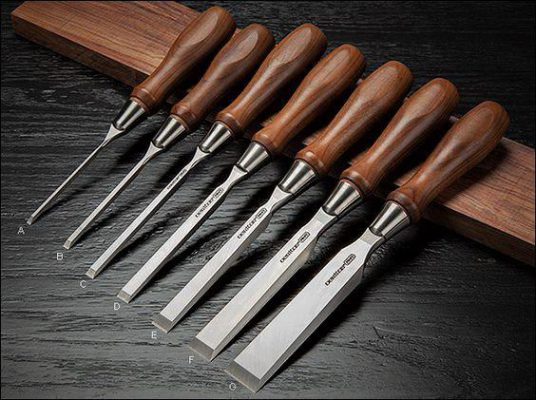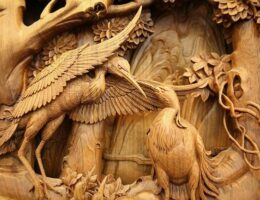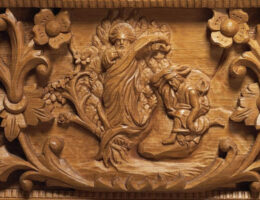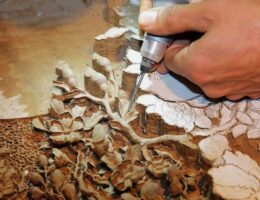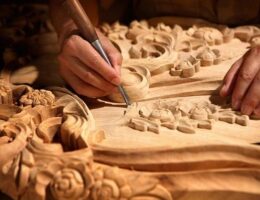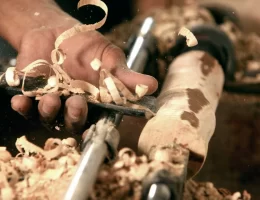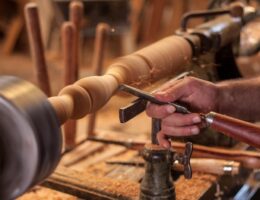IRAN ART EXHIBITION: WOOD CARVING IS COMBINATION OF ART AND PATIENCE
Many consider the Iranian handicrafts one of the main tourist attractions of Iran. Woodcarving known in the Persian language as “Monabat Kari” is a unique and delicate process of creating magnificent pieces of art with simple tools. Amazing engravings are created by master craftsmen by mostly using just a piece of wood and a metal hammer. Landscapes, Persian calligraphy and traditional mosaics are just a few examples of what the woodcarving master artists beautifully engrave on wood.
Monabat kari in Iran has very deep and historic roots with findings that prove this type of art was common in ancient Persia over a 1500 years ago. The Persians were well known for their artistic tastes and master craftsmanship with the art of Monabat kari starting at very modest shapes and styles but slowly changing into a delightful form of art. Today Monabat Kari comes in some very complex designs and shapes that excite the viewers and show how this traditional and ancient form of Persian art has evolved.
Monabat kari not only involves the creativity and steady hands of the artists, it importantly requires their patience. Thousands of hammering hits varying in speed and in several angles are required to create a piece of art with little to no margin for error. Taking these aspects into mind, one can see why the Iranian art of Monabat kari is considered valuable all around the world. As mentioned, this form of art has been around for many centuries and throughout the Persian history, most dynasties have beautifully used this art in various forms. Door and window frames, stamps, ceiling carvings and large designed frames are some of the few pieces of Monabat kari that travelers to Iran shall see in the historic monuments and palaces.
Iranian woodcarving is created step by step and the first and maybe most important one is choosing the right piece of wood. The most used wood for Monabat kari is taken from walnut trees which are solid foundation for any chiseling required on them. Choosing a design and the approach for starting it is also key to creating the best possible form of this art. Alongside the delicate hammering, sandpapering and removing rough edges in the piece is also essential. Tourists in Iran purchasing Monabat Kari should make sure their purchase has the least amount of roughness. The final stages of Monabat Kari require specially treating the wood with various paints and oils to keep the wood away from moisture.
The Iranian Monabat kari is one of the best Persian handicrafts showcasing the artistic taste of the Iranians and makes a wonderful piece of art to decorate any tourists home. Shiraz is one of the best places to purchase Monabat Kari and is a very popular art in that city.
IRAN ART EXHIBITION: As one of the most delicate handicrafts, Monabat Kari is the art of carving and engraving wood. It is a combination of the craft and diligence of artists who create exquisite artworks using simple and inexpensive materials. They carve their imagination on the wood in the form of Kufic, arabesque, Khatai, and Gol-o Morgh [flower and bird] patterns using only metal engravers and chisels. In Monabat Kari, the patterns are carved using relief technique. Carving is also applied in several other wood arts such as woodturning, wood molding, and Moaragh Kari [wood inlaid working or marquetry]. However, they cannot be listed under Monabat Kari which includes a non-homogeneous carving to achieve a relief pattern of the intended designs. As the preliminary designs of traditional Monabat included flora patterns, the name was taken from “Naba’at” meaning plant or vegetation in Arabic. The history of Achaemenid Monabat Kari shows that ordinary people used wood as an inexpensive and available material thousands of years ago. Wood is not much durable against natural factors and may be changed by heat, humidity, and other factors. Therefore, past Monabat works are not available today. In Iran, woodcarving is thousands of years old and it was used on sword and spear hilts and wooden shields of Medes and Achaemenid army men. Later, it was extended to present-day doors, windows, and furniture. Gol-o Morgh Monabat is one of the most ancient genres of woodcarving in Iran. Several historians and archaeologists have traced Monabat Kari back to the period before the Sasanian Empire, indicating the ancient history of the art in Iran. The oldest Monabat work in Iran is a wooden door in Jameh Mosque of Atigh in Shiraz. It is evident that wood is the main material in the uniform texture of the works and they could be made by a large range of jungle woods. In general, woods from walnut, pear, plane, elm, beech, black poplar trees and boxwood are used in Monabat Kari. Each type has a different texture and color and altogether are valuable and great for creating artworks. In Monabat Kari, the right type of wood should be selected based on the design. Given that the durability and beauty of the wood need to be preserved, it is important to pay much attention to selecting the proper type of wood. Compressed and strong hardwood should be used and softwood has no place in Monabat Kari. In addition to compression and firmness, it should be healthy and uniform.
Adam Olearius, a German traveler, wrote in his diary on the art of wood: “In Iran it is used to make rectal carved windows and it is also used for the roofs of buildings”.
The Monabbat-kāri technique consists in the creation of hollow and relief artifacts on wooden surfaces, with the use of different types of tools, taking as a reference precise and detailed schemes. Monabat is a word of Arabic origin that refers to the growth of plants.
Some believe that this type of processing with floral motifs or that recalls the plant world, represents the growth of plants and for this reason is called Monabat. Unfortunately, due to the low resistance of the wood, no works dating back to antiquity have been found. The most ancient sculpture has been found in Egypt and dates back to 2500 years BC Also on the Iranian Plateau some small cylindrical wooden spheres with various decorations were found, demonstrating that even the Arians knew this art. Arthur Pope, an American Iranologist, wrote: “The art of engraving on precious stones and wood dates back a few thousand years, before the Achaemenid dynasty, and subsequently inspired the Greeks as well. Among the bas-reliefs from the cities of Susa and Persepolis, located in the south and south-west of Iran, there are also some wooden handicrafts. After the advent of Islam in Iran (XNUMXth century AD) there was a very flourishing period for Monabat art, and in this style furnishings for sacred buildings were made, such as doors, windows, tables and minbar (pulpits for mosques). In the Safavid period, doors, windows, columns, tables, dishes and sword handles were made of wood using the carving technique. Today we can notice it on objects such as sticks, candlesticks and on different types of traditional musical instruments, such as tar, setar etc .; or on portraits of famous people, where other materials such as buffalo or deer horn are used instead of wood.
IRAN ART EXHIBITION: The oldest workmanship in Monabat is visible on a door of the Atigh Mosque in the city of Shiraz dating back to the early Christian ninth century, built in poplar wood and decorated with the carving technique. The following ones, dating back to the tenth century, are made of walnut and bear inscriptions in calligraphic cuficas. After the Safavid dynasty due to conflicts and political instability, this art was almost forgotten and returned to the fore later with the advent of the Qajarid dynasty. Today the Monabat-kāri technique is used only for the production of ornamental objects and is part of a very important sector within the wood craftsmanship. Most of these objects are exported overseas. The most famous cities for this type of handicraft are: Abadeh, located in the Fars region, Golpayegān located in the Esfahan region and the city of Buschehr in the Hormozgan region. There are two types of Monabat-kāri: one with very small intaglio designs and the other with fairly large designs. For the realization of sculptures, paintings or art objects decorated with floral, geometric motifs and portraits and figures of animals, you can use wood, bone or ivory. The wood most suitable for this type of art must be quite soft, durable and smooth. It must also have a beautiful color, without veins. Those used are usually: walnut, maple, beech, eucalyptus, gioggiolo, pear, pomegranate etc. The tools used are the knife, the saw, the rasp, the file, the chisel and different types of blades. The technique is performed in two ways: one is the hollow carving with geometric decorations and triangular or linear designs, the other is a relief carving with floral motifs, human or animal figures.
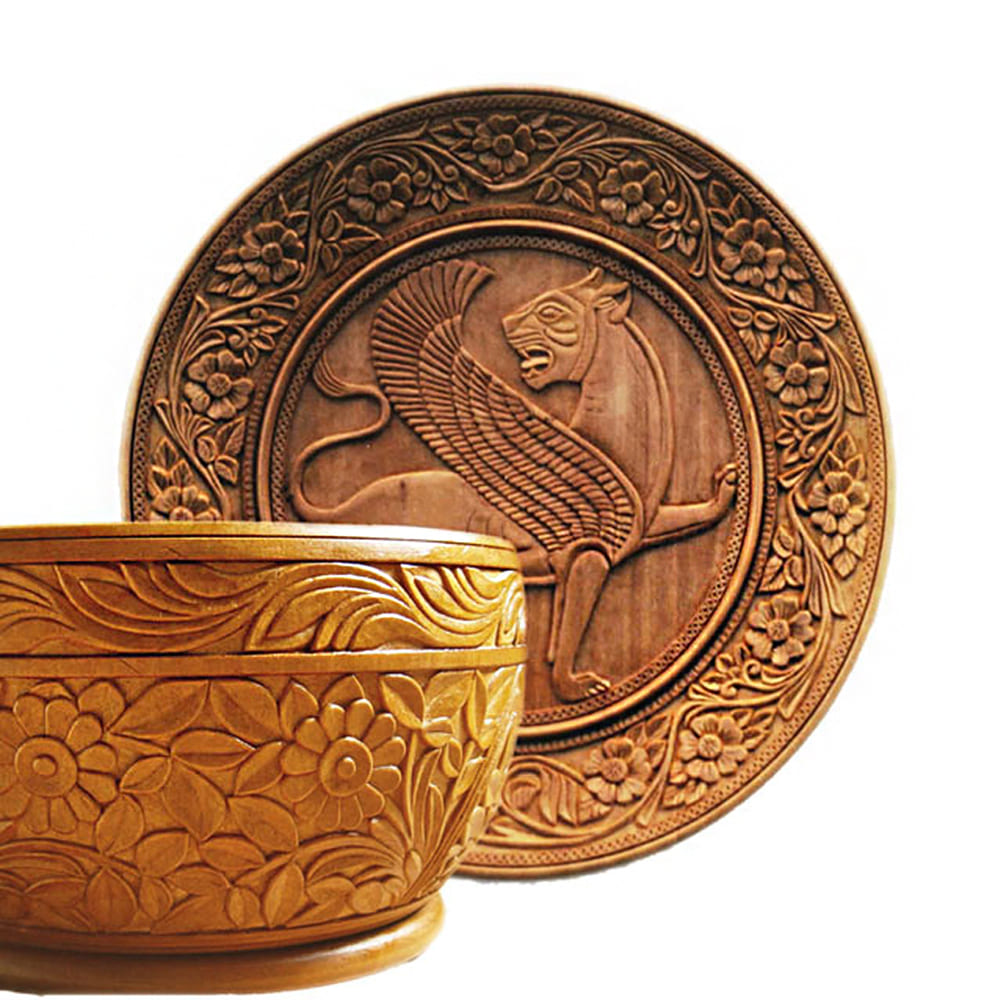
Its artisans create highly artistic and valuable consumer goods from cheap and great deal of initial materials. Although wood is not durable against environmental elements, palaces doors, boxes over graves, raised structures for preaching in mosques, etc. which belongs to the remote old times shows the flourish and spread of this art in Iran.
Wood carving involves carving of wood based on accurate designs. This, as a simple and written definition, does not remind any memory to the mind. But each carved piece of wood is a good sample of its creator’s feeling, perception, and thought.
IRAN ART EXHIBITION: The history of wood carving, like the other arts and crafts which was born and grown among scattered populations whose founders were ordinary people, is not so clear. Actually, it can not be said from which era this art industry flourished. But unquestionably, wood as the most plentiful material in nature is the first thing that drew man’s attention to itself and was used for making artistic and consumer goods. Based on the available documents, wood carving in Iran goes back to 1500 years a go. Even a number of researchers explicitly declare that it was flourished before Sasanians in Iran. But there are no historical documents to prove this.
The most ancient wood carved work which goes back to the first half of the third century A.H. belongs to Atigh mosque in Shiraz. It was created of poplar wood in Omar En Leice Safari era. It is decorated with very beautiful polygon designs out of walnut wood. After this, the other work which is the upper part of a door carved out of deal and belongs to the fourth century A.H. should be pointed. It is delicately carved with Kufic scripts of 3 centimeters thick.
With regard to the moral dissemination of building Islamic centers and mosques after the manifestation of Islam, Iranian artists made their best to decorate mosques. Along with architects, tilers, masons, and plaster moulders; wood carvers were fascinated by performing their art in this way. Unfortunately there are not a lot of samples of their works. Yet, relaying on those rare remains, it can be said that what were used for decoration of mosques_ in the shape of raised structures for preaching, doors, and windows_ are very valuable samples of Iranian art and talent.
IRAN ART EXHIBITION: In Safavid era, considering the eye-catching and noticeable development of religious buildings and royal palaces, a great number of artists went to the center of the country Isfahan where the most of the above mentioned buildings were constructed. One of the results of their gathering in one place that caused the creation of marvelous and worthy of everlasting works, was the exchange of their skills and experiments.
